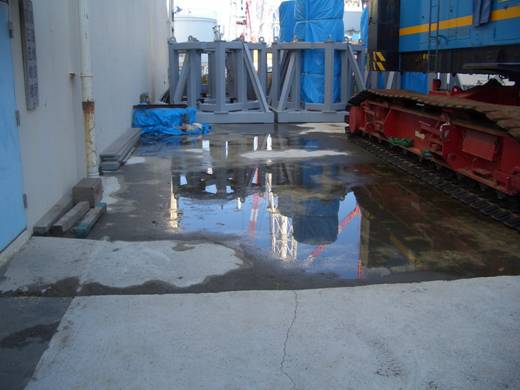(UPDATE) Link to Babcock & Wilcox page on the modular nuclear reactors: http://www.babcock.com/products/modular_nuclear/
One to 10 units per site, less than 5% enriched uranium, 4 years between refueling.
Link to DOE press release: http://energy.gov/articles/obama-administration-announces-450-million-design-and-commercialize-us-small-modular
The president will give $450 million to these rich multinationals like B&W, Bechtel. He will end up effectively giving away the similar amount to Solyndra alone ($385 million out of $535 million), so it's only fair, I suppose.
===================================
Fukushima? What is that? How do you pronounce the word?
President Obama, who may be keen to use corporate donations to fund his second inauguration ceremony in January, wants to spread the wonderful clean energy even to "small, remote areas that cannot support traditional reactors".
Judging from the Oilprice.com's article below, it will be based on the technology for the nuclear reactors on board the US Navy's submarines and aircraft carriers.
The Obama administration will fund 50% of the project to design and commercialize small, modular reactors, with the other 50% by Babcock & Wilcox, TVA, Bechtel International, and Mr. Bill Gates.
I posted an article about Babcock & Wilcox in October. It's the company who "filed for Chapter 11 bankruptcy in part as a result of thousands of claims for personal injury due to prolonged exposure to asbestos and asbestos fibers (from Wiki).
For Mr. Gates, to have inflicted buggy Microsoft products on the entire world for the past 20-plus years is clearly not enough.
After the disastrous support for alternative energy companies and start-ups (like this one) that went belly-up after extracting large amounts of cheap loans from his administration, it seems Mr. Obama has decided it's safer to bet on the old, established multinationals.
It's not his own money anyway.
From Oilprice.com email newsletter (11/24/2012; emphasis is mine), by the editor James Stafford:
Greetings from London.
This week in energy, let’s go nuclear for a change.
And let’s start with the Obama administration’s plans for a new generation of nuclear power. This time around things will be smaller and ostensibly safer.
This new nuclear generation was given greater impetus on Tuesday when the administration announced it would fund up to 50% of the cost of a 5-year project to design and commercialize small, modular reactors.
Who’s funding the other 50%? The project, which hopes to be operational by 2022, will be led by Babcock & Wilcox energy technology company of Charlotte, in partnership with the Tennessee Valley Authority and Bechtel International. And of course, we can’t forget Bill Gates, a key private investor.
What is unique about the project is the small modular reactor design. They are about one-third the size of existing reactors. The technology used has already been implemented by the US Navy, but not commercialized. The administration is keen to point out that this new nuclear generation represents lower upfront costs, higher safety standards and greater flexibility—they can be used in small, remote areas that cannot support traditional reactors.
They are assembled at a factory site and transported, ready to use, to their intended location.
In terms of costs, these small modular reactors have a $250 million price tag, compared with as much as $9 billion for the typical large reactors currently built in the US.
What will this new nuclear generation mean for consumers’ utility bills? Well, no one can say with any certainty just yet. Whether these new reactors would translate into cheaper electricity prices has not been definitively demonstrated, though it is of course an ultimate goal.
Low natural gas prices are also a bit of a worry for the nuclear industry as a whole.
While nuclear is experiencing a bit of a revival in the US and coal languishes in its death throes, globally, coal is enjoying gains. Some 1,200 new coal plants are in the works worldwide—the bulk of them in China and India—as countries take advantage of cheap coal prices in the US. But even Europe is importing increasing amounts of coal from the US. US coal exports have reached a decade high.
For Europe, this is troubling. As the European public puts increasing pressure on governments to abandon any dreams of fracking shale gas reserves over environmental concerns, the energy gap is being filled in by more polluting coal. This is the subject of our special investor piece today. There is good news—and bad. While the European Parliament has rejected a fracking ban proposal, this doesn’t mean we’re about to see a shale gas free-for-all. Hurdles and pitfalls abound.
Another developing trend that has caught our eye is what appears to be the declining attraction of Canada’s oil sands among US companies. A recent report put out by Peters & Co. energy investment bank of Calgary notes that there are some $17 billion in Canadian oil sands assets up for sale right now. The logic holds that US companies are trying to get out. The report points out that the $17 billion is the equivalent of assets sold throughout the past decade.
Finally, amid all the hubbub of the International Energy Agency’s (IEA) dramatic report about the US overtaking Saudi Arabia as the world’s largest oil (oops, hydrocarbons) producer, we’ve missed something in that figure-manipulating report: A largely unnoticed blurb about California’s energy woes end with the information that the Monterrey Formation in Southern California has 15.4 billion barrels of recoverable crude oil. This puts Bakken (North Dakota) to shame. It’s four times the volume of Bakken.
Ah yes, the Monterrey Formation in So-Cal. It will be extracted when Hell freezes over, as they say, or the Democrats lose majority in the State Assembly. (Meaning it will never happen, just in case you are wondering.)
Anti-nuclear people in the US, it's your tax money that will fund these new nuclear reactors, whether you like it or not.











 Tokyo Time
Tokyo Time
![[Most Recent Quotes from www.kitco.com]](http://www.kitconet.com/charts/metals/gold/t24_au_en_usoz_2.gif)

